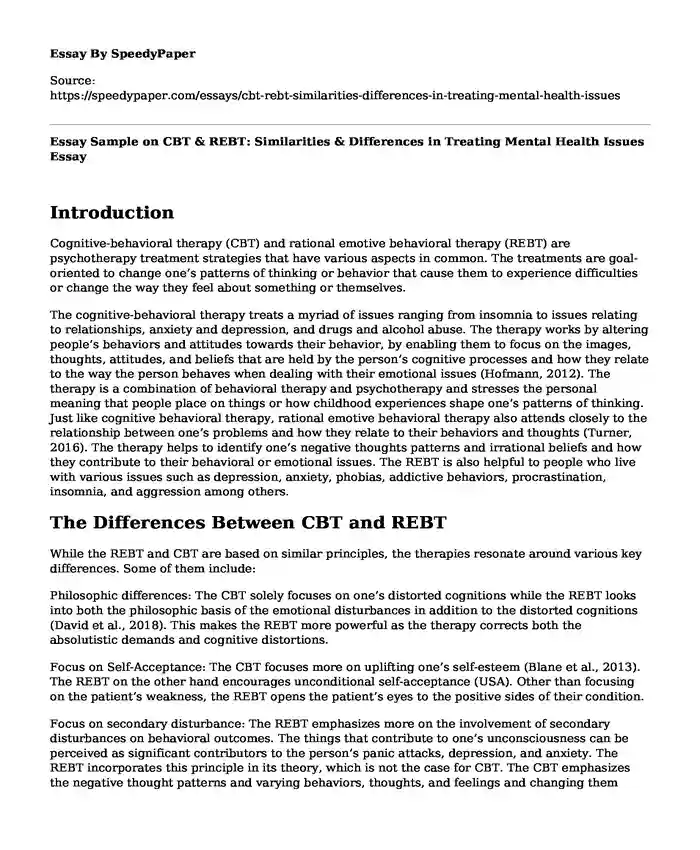
| Type of paper: | Essay |
| Categories: | Psychology Mental health |
| Pages: | 3 |
| Wordcount: | 678 words |
Introduction
Cognitive-behavioral therapy (CBT) and rational emotive behavioral therapy (REBT) are psychotherapy treatment strategies that have various aspects in common. The treatments are goal-oriented to change one’s patterns of thinking or behavior that cause them to experience difficulties or change the way they feel about something or themselves.
The cognitive-behavioral therapy treats a myriad of issues ranging from insomnia to issues relating to relationships, anxiety and depression, and drugs and alcohol abuse. The therapy works by altering people’s behaviors and attitudes towards their behavior, by enabling them to focus on the images, thoughts, attitudes, and beliefs that are held by the person’s cognitive processes and how they relate to the way the person behaves when dealing with their emotional issues (Hofmann, 2012). The therapy is a combination of behavioral therapy and psychotherapy and stresses the personal meaning that people place on things or how childhood experiences shape one’s patterns of thinking. Just like cognitive behavioral therapy, rational emotive behavioral therapy also attends closely to the relationship between one’s problems and how they relate to their behaviors and thoughts (Turner, 2016). The therapy helps to identify one’s negative thoughts patterns and irrational beliefs and how they contribute to their behavioral or emotional issues. The REBT is also helpful to people who live with various issues such as depression, anxiety, phobias, addictive behaviors, procrastination, insomnia, and aggression among others.
The Differences Between CBT and REBT
While the REBT and CBT are based on similar principles, the therapies resonate around various key differences. Some of them include:
Philosophic differences: The CBT solely focuses on one’s distorted cognitions while the REBT looks into both the philosophic basis of the emotional disturbances in addition to the distorted cognitions (David et al., 2018). This makes the REBT more powerful as the therapy corrects both the absolutistic demands and cognitive distortions.
Focus on Self-Acceptance: The CBT focuses more on uplifting one’s self-esteem (Blane et al., 2013). The REBT on the other hand encourages unconditional self-acceptance (USA). Other than focusing on the patient’s weakness, the REBT opens the patient’s eyes to the positive sides of their condition.
Focus on secondary disturbance: The REBT emphasizes more on the involvement of secondary disturbances on behavioral outcomes. The things that contribute to one’s unconsciousness can be perceived as significant contributors to the person’s panic attacks, depression, and anxiety. The REBT incorporates this principle in its theory, which is not the case for CBT. The CBT emphasizes the negative thought patterns and varying behaviors, thoughts, and feelings and changing them using concrete skills.
These differences might significantly contribute to my practice as a mental health counselor. The philosophic differences and Unconditional Self-acceptance (USA) will enable me to help the patient to accept his/her condition to make the treatment more powerful. A focus on secondary disturbance will help to understand the secondary factors that contribute to the psychological problems and establish the necessary concrete skills to control the problem.
The Preferred Therapy
I would prefer to use the Rational Emotive Behavioral Theory (REBT) with my clients. This is because, a proper address of a client’s issues in nursing revolves around the patients accepting themselves and their conditions, understanding their philosophy, and environment (Kim & Yoon, 2018). These factors among others contribute towards proper medication and healing for the client. The REBT includes all these aspects in its therapy as opposed to the CBT. This makes the theory more reliable for use with clients.
References
Blane, D. et al. (2013). Cognitive-behavioral therapy: Why primary care should have it all. British Journal of General Practice. https://bjgp.org/content/63/607/103
David, D. et al. (2018). Why cognitive behavioral therapy is the current gold standard of psychotherapy. Ncbi.nlm.nih.gov. https://www.ncbi.nlm.nih.gov/pmc/articles/PMC5797481/
Hofmann, S. et al. (2012). The efficacy of cognitive-behavioral therapy: A review of meta-analyses. Ncbi.nlm.nih.gov. https://www.ncbi.nlm.nih.gov/pmc/articles/PMC3584580/
Kim, H., and Yoon, S. (2018). Effects of group rational emotive behavior therapy on nurses’ job stress, burnout, job satisfaction, organizational commitment, and turnover intention. Korean Society of Nursing Science. https://synapse.koreamed.org/search.php?where=aview&id=10.4040/jkan.2018.48.4.432&code=0006JKAN&vmode=PUBREADER
Turner, M. (2016). Rational Emotive Behavior Therapy (REBT), irrational and rational beliefs, and the mental health of athletes. Frontiers in Psychology. https://www.frontiersin.org/articles/10.3389/fpsyg.2016.01423/full
Cite this page
Essay Sample on CBT & REBT: Similarities & Differences in Treating Mental Health Issues. (2023, Sep 12). Retrieved from https://speedypaper.net/essays/cbt-rebt-similarities-differences-in-treating-mental-health-issues
Request Removal
If you are the original author of this essay and no longer wish to have it published on the SpeedyPaper website, please click below to request its removal:
- Essay Example on Genetics of Parathyroid Tumors
- Medicine Essay Example: Genitalia Assessment Using a SOAP Note
- Essay Sample on Drug Addiction Treatment
- Essay Sample on Ethical Dilemmas Encountered in the Nursing Practice
- Paper Example. The Issue of Anxiety and Depression in Higher Education Institutions
- Improving Patient Safety: Leveraging Health IT to Reduce Diagnostic Errors - Paper Example
- Essay Sample on Depression in Teens
Popular categories




